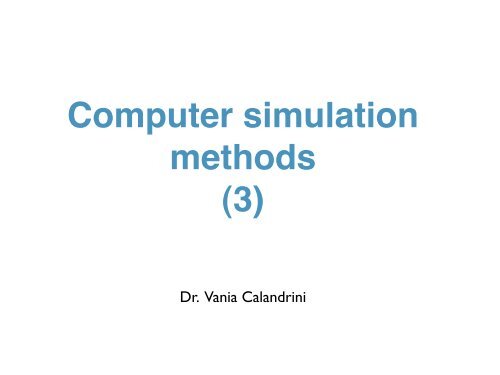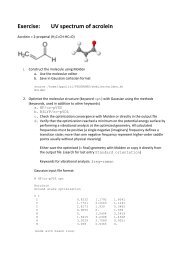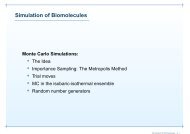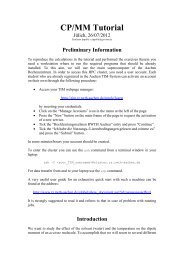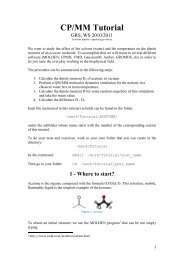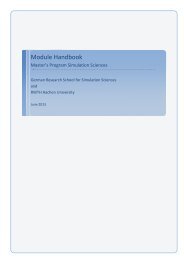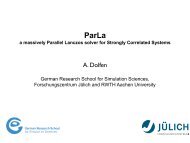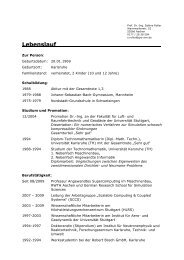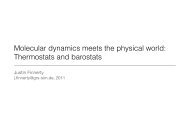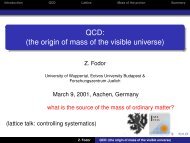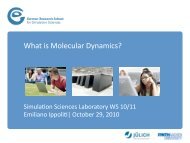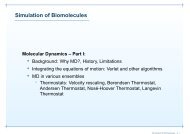Computer Simulation Methods 3
Computer Simulation Methods 3
Computer Simulation Methods 3
You also want an ePaper? Increase the reach of your titles
YUMPU automatically turns print PDFs into web optimized ePapers that Google loves.
<strong>Computer</strong> simulation<br />
methods<br />
(3)<br />
Dr. Vania Calandrini
in the previous lecture:<br />
setting up a simulation<br />
boundaries<br />
monitoring the equilibration<br />
short-range and long-range interactions<br />
minimum image, cutoff and related problems/solutions<br />
Ewald summation<br />
Particle Mesh Ewald summation
Molecular dynamics<br />
Classical Molecular<br />
Dynamics<br />
technique for computing the equilibrium and transport properties of a<br />
classical many-body system.<br />
the nuclear motion of the constituents particles obeys the laws<br />
of classical mechanics (hυ υ< 6ps -1 at 300 K )<br />
These vibrations are not well treated by<br />
classical physics. They require quantum<br />
mechanics simulations.<br />
These data are used as input in molecular<br />
dynamics simulations to parametrize the<br />
characteristic frequencies of the potential.
In molecular dynamics, successive configurations are generated by integrating Newtonʼs<br />
laws of motion. The result is a trajectory that specifies how the positions and velocities of<br />
the particles in the system vary with time.<br />
1) a body continues to move in a straight line at constant velocity unless a force acts upon it<br />
2) force equals the rate of change of momentum<br />
3) to every action there is an equal and opposite reaction<br />
The trajectory is obtained by solving the differential equations embodied in Newtonʼs second<br />
law:<br />
m i¨r i ≡ ṗ i = − ∂V =Fi = F i<br />
∂r i<br />
ṙ i = p i<br />
m i<br />
conservative system :<br />
each atom is represented<br />
by a mass point<br />
ri<br />
V = V (r 1 , r 2 ,...,r n )
Time and Spatial scales<br />
MD simulations<br />
(atomic details):<br />
Biological<br />
Systems:<br />
~ 10 -12 to 10 -7 s<br />
~ 10 -10 to 10 -8 m<br />
~ 100 000 particles
Molecular dynamics with continuous<br />
Potentials<br />
Under the influence of a continuous potential the motions of all the particles are coupled<br />
together, giving rise to a many body problem that cannot be solved analytically=> then the<br />
equations of motion are integrated numerically<br />
Numerical integration of motion equations : Finite difference methods<br />
the integration is broken down into many small stages, each separated in time by a fixed δt: forces acting on<br />
each particle at time t are computed knowing the positions of all the particles. Then the accelerations together<br />
with the positions and velocities at time t are used to compute the new positions and velocities at time t+δt.<br />
During each time step the force is assumed to be constant.<br />
Taylor series<br />
expansions:<br />
Any finite difference integrator is naturally an approximation for a system developing<br />
continuously in time.
The integrator is responsible for the accuracy of the simulation results.<br />
Main requirements:<br />
• Stable: it has to conserve energy<br />
• Robust, in the sense that it allows for large time steps in order to propagate the system<br />
efficiently through phase space
Verlet algorithm :<br />
adding up (1) and (2):<br />
(1)<br />
(2)<br />
Taylor’s<br />
expansions<br />
Δt→0<br />
or:<br />
next current previous<br />
requires the storage of old and current positions<br />
subtracting (2) from (1) one can derive the velocity from the knowledge of the trajectory:<br />
or:
Verlet algorithm :<br />
requires the storage of old and current positions<br />
the velocities are not available until the positions have been computed at the next step<br />
it is not a self starting algorithm: at t=0 you have only one set of positions. To obtain the<br />
positions et t=-δt, one can use eq. 2 truncated after the first term:<br />
low precision<br />
time reversible = reversing the momenta of all particles at a given instant, the system<br />
trace back its trajectory in phase space
Leap frog algorithm :<br />
positions and velocities not synchronized
velocity Verlet algorithm :<br />
(1)<br />
v(t + ∆t<br />
2 )=v(t)+∆t 2<br />
f(t)<br />
m + O(∆t2 )<br />
Δt/2→0<br />
Taylor’s expansion<br />
(2)<br />
r(t + ∆t) =r(t)+v(t + ∆t<br />
2 )∆t + O(∆t2 )<br />
from the mean<br />
value theorem or<br />
central difference<br />
(3)<br />
v(t + ∆t) =v(t + ∆t<br />
2 )+∆t 2<br />
f(t + ∆t)<br />
m<br />
f(t + ∆t) =−<br />
- Velocity Verlet requires only the storage of current positions.<br />
- Verlet and velocity Verlet schemes produce exactly the same trajectory<br />
approximation of derivatives by finite differences :<br />
forward difference<br />
backward difference<br />
central difference<br />
δV (r(t + ∆t))<br />
δr<br />
+ O(∆t)<br />
from the<br />
backward<br />
difference
High-order schemes: predictor-correctors<br />
The basic idea is to use r(t) and its first n derivatives at time t to make a prediction for<br />
r(t+ Δt) and its first n derivatives at time t+ Δt. We then compute the forces (i.e.<br />
accelerations) at the predicted positions and find that these forces are different from<br />
the predicted ones. So we adjust our predictions for the accelerations to match the<br />
facts. Moreover, on the basis of the observed discrepancy between the predicted and<br />
observed accelerations, we also try to improve our estimate of the positions and the<br />
remaining n−1 derivatives. the “recipe” used in applying this correction is a<br />
compromise between accuracy and stability.<br />
see Understanding Molecular <strong>Simulation</strong> by Daan Frenkel<br />
and Berend Smit for some specific examples of a predictor<br />
corrector algorithm.
Comments:<br />
• Although, computational speed seems important, it is usually not very relevant, because<br />
the fraction of time spent on integrating is usually small (as opposed to computing<br />
interactions) at least for simple molecular system.<br />
• Accuracy: we can consider the integration error as the source of the divergence between<br />
the “true” trajectory and the computed trajectory compatible with the same initial conditions<br />
(note that this problem need not to be serious in molecular dynamics (MD) simulations<br />
since the aim of an MD simulation is to predict the average behavior and not what will<br />
precisely happen to a system in a known initial condition. It has been proven that MD<br />
simulations provide good statistical predictions for many systems.)<br />
• Algorithms that allow the use of large time steps require the storage of increasingly higher<br />
order derivatives.<br />
• Energy conservation: higher order algorithms tend to have very good energy<br />
conservation for short times, while the overall energy drifts for long times. In contrast Verlet<br />
algorithms tend to have only moderate short term energy conservation but little long-term<br />
drift.<br />
•Time reversibility (= reversing the momenta of all particles at a given instant, the system<br />
trace back its trajectory in phase space): many algorithms such as predictor-correctors are<br />
not time reversible.Verlet scheme is time reversible.
Tutorials
Required programs:<br />
NAMD<br />
VMD<br />
a parallel molecular dynamics code designed for high-performance simulation of<br />
large biomolecular systems.<br />
VMD is a molecular visualization program for displaying, animating, and analyzing<br />
large biomolecular systems using 3-D graphics and built-in scripting. It can be used<br />
to setup simulations and analyze trajectories .<br />
by the Theoretical and Computational Biophysics Group at the Beckman Institute for<br />
Advanced Science and Technology of the University of Illinois at Urbana-Champaign<br />
you need also a text editor and a plotting program
Tutorial<br />
http://www.ks.uiuc.edu/Training/Tutorials/namd-index.html<br />
NAMD Tutorial<br />
the examples in the tutorial will focus on the study of a small protein, ubiquitin<br />
purpose:<br />
- basic steps of a molecular dynamics simulation, i.e., preparation, minimization, and<br />
equilibration of your system.<br />
- typical simulation techniques and analysis of equilibrium properties<br />
- descriptions of all files needed for the simulations
To do:<br />
do this analysis for<br />
water box
careful<br />
reading
in this lecture:<br />
Molecular dynamics with continuous Potentials:<br />
time and spatial scales<br />
finite difference methods:<br />
Verlet algorithm<br />
velocity Verlet algorithm<br />
Leap frog algorithm<br />
Tutorial (using NAMD and VMD):<br />
basic steps of a molecular dynamics simulation, i.e., preparation, minimization, and<br />
equilibration of the system and analysis of equilibrium properties
for any question:<br />
v.calandrini@grs-sim.de


